The Membrane Filtration Systems Market is estimated to be valued at USD 20.2 billion in 2025 and is projected to reach USD 37.6 billion by 2035, registering a compound annual growth rate (CAGR) of 6.4% over the forecast period.
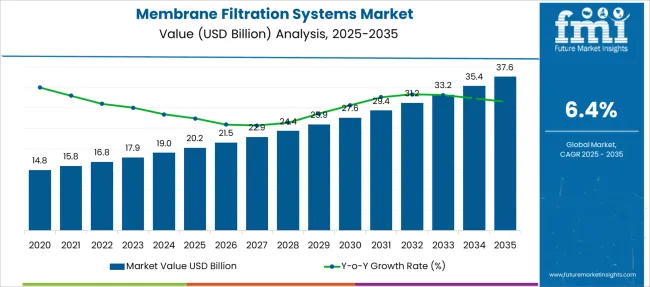
| Metric | Value |
|---|---|
| Membrane Filtration Systems Market Estimated Value in (2025 E) | USD 20.2 billion |
| Membrane Filtration Systems Market Forecast Value in (2035 F) | USD 37.6 billion |
| Forecast CAGR (2025 to 2035) | 6.4% |
The membrane filtration systems market is expanding due to the increasing need for efficient water and wastewater treatment solutions globally. Growing concerns about water scarcity and environmental pollution have driven investments in advanced filtration technologies to ensure safe and sustainable water resources.
The demand for membrane systems has been boosted by stricter regulations on water quality and the rising adoption of decentralized treatment facilities. Innovations in filtration modules and materials have improved system performance, reliability, and cost-effectiveness.
As industries and municipalities seek to optimize their water treatment processes, membrane filtration offers a scalable and energy-efficient solution. The market outlook is positive as awareness about water conservation intensifies and infrastructure development accelerates in emerging regions. Segmental growth is expected to be led by water and wastewater applications, spiral wound module designs, and polymeric membranes due to their effectiveness and widespread use.
The market is segmented by Application, Module Design, Membrane Material, and Technique and region. By Application, the market is divided into Water & Wastewater and Food & Beverages. In terms of Module Design, the market is classified into Spiral Wound, Tubular Systems, Plate & Frame, and Hollow Fiber. Based on Membrane Material, the market is segmented into Polymeric and Ceramic. By Technique, the market is divided into Reverse Osmosis(RO), Ultra filtration (UF), Microfiltration(MF), and Nano filtration(NF). Regionally, the market is classified into North America, Latin America, Western Europe, Eastern Europe, Balkan & Baltic Countries, Russia & Belarus, Central Asia, East Asia, South Asia & Pacific, and the Middle East & Africa.
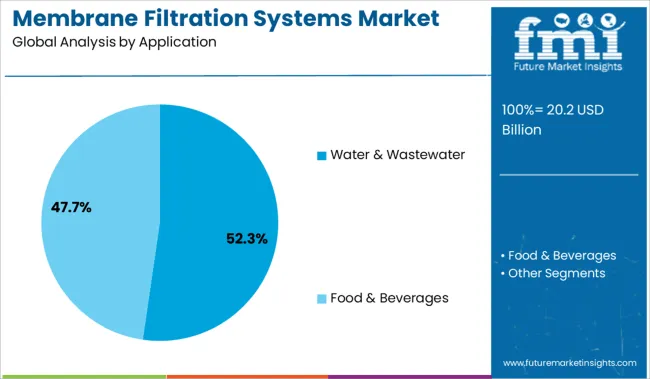
The water and wastewater application segment is projected to hold 52.3% of the membrane filtration systems market revenue in 2025, making it the dominant application area. This growth is attributed to the increasing demand for clean water across municipal and industrial sectors. Stringent discharge regulations and the need for recycling and reuse have encouraged the adoption of membrane filtration to remove contaminants efficiently.
Treatment facilities require reliable and scalable filtration technologies to handle varying water qualities and volumes. The segment benefits from the versatility of membrane systems, which can be tailored to address specific pollutants and treatment goals.
Growing urbanization and industrial expansion have further amplified the need for effective water and wastewater treatment, driving this segment’s continued market leadership.
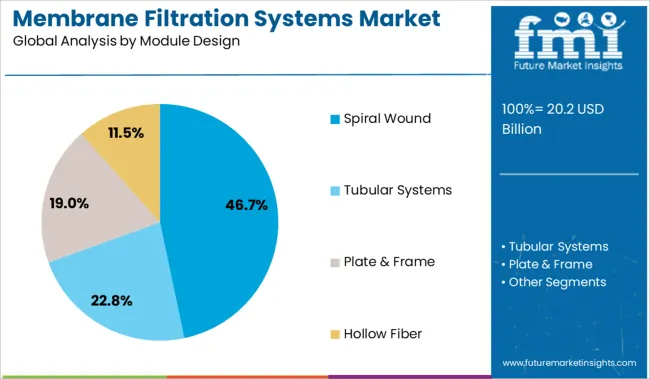
The spiral wound module design segment is expected to contribute 46.7% of the market revenue in 2025, leading the module design categories. Spiral wound modules are favored for their compact design and high packing density, which enable efficient use of space and high filtration performance. These modules provide a balanced flow path and are effective for a variety of filtration applications, including reverse osmosis and ultrafiltration.
Their ease of maintenance and replacement also supports their preference among operators. The widespread compatibility of spiral wound modules with various membrane materials adds to their versatility.
As treatment facilities seek cost-effective and space-efficient solutions, the spiral wound design is anticipated to remain the preferred choice.
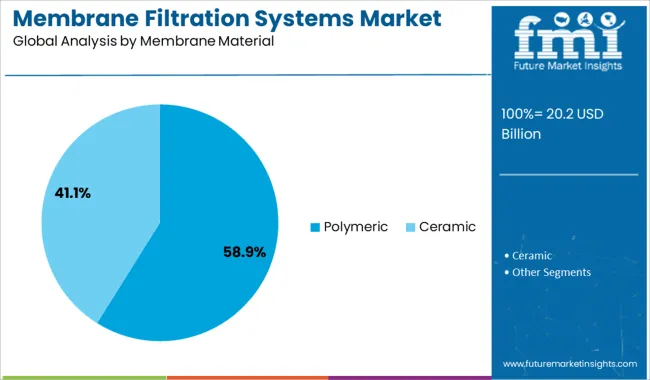
The polymeric membrane material segment is projected to hold 58.9% of the market revenue in 2025, dominating the membrane materials category. Polymeric membranes are preferred due to their excellent chemical resistance, flexibility, and cost efficiency. They can be engineered to achieve high selectivity and permeability, making them suitable for diverse filtration needs.
These membranes also exhibit good mechanical strength and are compatible with various module designs. The ongoing development of advanced polymer blends and coatings has enhanced membrane durability and fouling resistance.
Given their scalability and adaptability, polymeric membranes continue to be the material of choice for many water treatment applications, sustaining their market leadership.
| Market Statistics | Details |
|---|---|
| H1,2024 (A) | 6.3% |
| H1,2025 Projected (P) | 6.4% |
| H1,2025 Outlook (O) | 7.0% |
| BPS Change : H1,2025 (O) - H1,2025 (P) | (+) 64 ↑ |
| BPS Change : H1,2025 (O) - H1,2024 (A) | (+) 70.4 ↑ |
Membrane filtration is a process that uses a semipermeable membrane to separate substances from one another. The membrane allows small molecules to pass through while preventing the passage of larger molecules.
This process is used in industrial and laboratory settings to purify water, produce fuel, and extract valuable compounds from raw materials. Membrane filtration has also been used in the medical field to treat kidney disease and improve water quality in developing countries.
The global market for membrane filtration system market is witnessed H1 2024 growth at magnitude of 6.3%. However, this growth is not evenly spread across all regions, with the developing markets recording higher growth rates of 7.4% (H1 2025 Expected). Thus, leaving the gap of +70.4 BPS points between expected and projected growth during H1 2025.
In the water and wastewater treatment industry, membrane filtration is a growing technology. Its popularity is due to its ability to remove smaller particles than traditional filtration methods. This makes it an ideal choice for treating water with high levels of suspended solids. In addition, membrane filtration is more energy efficient than other technologies, which makes it a more cost-effective option in the long run.
Despite its advantages, membrane filtration is not always the best choice for every application. It can be expensive to install and maintain, so it is not always practical for small-scale operations. And while it is effective at removing smaller particles, it may not be able to remove all of the larger ones. So before investing in a membrane filtration system, it's important to consider your specific needs and requirements.
Membrane filtration technology is gaining significant acceptance in the food & beverage industry for accruing the safety, quality, and shelf-life of food & beverage products. The major functions of membrane technology in the food industry include desalination, fractionation, standardization, concentration, and clarification or separation.
Membrane filtration systems are also used in segregating the emulsified oils in foods and beverages. These stretched applications of membrane filtration technology are contributing to the growth of the Membrane Filtration Systems Market.
India is envisaged to be the fastest-growing Membrane Filtration Systems Market for the food & beverage industry during the forecast period. The elevated demand for dairy products, government support through subsidies for membrane filtration systems in water purification, the growth in the purchasing power of the middle-class group for quality products, and the boost in consumption of cleaner functional foods and supplements are some of the key factors that are luring food processing companies to adopt membrane filtration systems.
Microfiltration (MF) is a separation device powered by pressure and is commonly used to concentrate, purify or remove macromolecules, colloids, and suspended particles from the solution. This is widely used for pharmaceutical cold sterilization.
It has been shown that pharmaceuticals lose their potency upon the introduction of heat. Bacteria, fat globules, and suspended solids are not able to pass through microfiltration.
MF membranes are used as a means of extracting bacteria and other harmful fluids from liquids, a procedure called 'cold sterilization,' which rejects heat use. In recent decades, the use of microfiltration technology has increased as pharmaceutical testing and product production have increased.
Microfiltration has thus become a vital part of pharmaceutical research and development, and potential demand for microfiltration technology is expected to increase.
Reverse osmosis (RO) technology is used to extract harmful pollutants from water. In general, this cycle extracts minerals like iron, chlorine, lead, salt, manganese, and calcium. In terms of water purification, reverse osmosis provides high efficiency; it can usually extract up to 99 percent of most mineral pollutants.
RO is thus experiencing remarkably high demand among techniques available in the market for water purification purposes.
In general, this method extracts minerals including iron, fluoride, lead, salt, manganese, and calcium. The water that is used in the beverage industry usually comes from municipal sources.
This water is drinkable but contains elements of hardness or deposits of heavy metals that typically come from the pipes that hold the water; these elements in the water that affect the taste of the water, and therefore the taste of the drinks. RO is therefore widely utilized in beverage production to prevent these problems.
Within the Membrane Filtration Systems Market, Asia Pacific holds more than 30% of the market share. The use of membrane filtration systems in water purification plants and the dairy and food industries for pasteurization, sterilization, and concentration processes in this region are generating enormous demands for membrane filtration systems technology.
India is the leading market for the food and beverage application of membrane filtration systems.
Asia Pacific membrane filtration systems market dominated by China. Mainly driving a country's membrane filtration systems market is the growing use of membrane filtration systems technology for water purification. The rising population in this country has resulted in an increasing need for sustainable purification technologies to ensure healthy drinking water supplies.
India is expected to be the fastest-growing food & beverage membrane filtration systems market during the review period.
Setup cost for membrane filtration systems is, however, a restraining growth to an extent as it is quite exorbitant. Also, almost all microfiltration and ultrafiltration membrane filtration systems are subject to a process called fouling.
Fouling is when deposited materials accumulate along the membrane surface, which accompanies an overall reduction in efficiency and heightened energy usage. Membrane fouling is one of the most common problems faced by membrane filtration end-users.
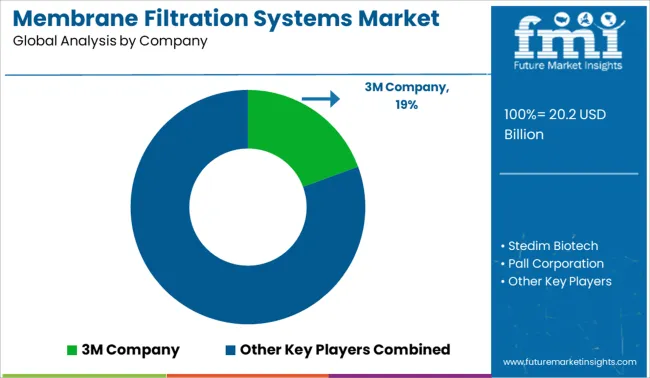
Key players operating in the global Membrane Filtration Systems Market are 3M Co., The Wabag Group, GEA Group, Dow Co., Cytiva, Koch Membrane Systems, Porvair, and Veolia Water Technologies.
These companies follow a range of strategies like product launches, event collaborations, joint research and development and acquisitions to dominant global realm of Membrane Filtration Systems Market.
The membrane filtration systems market is consolidated as majority of the membrane filtration technologies are being produced by the global key players. Moreover, Asia-pacific has some emerging small players due to the rise of awareness, making the overall membrane filtrations market expand.
| Attribute | Details |
|---|---|
| Market Size Value in 2024 | USD 20.2 billion |
| Market Forecast Value in 2035 | USD 37.6 billion |
| Global Growth Rate | 6.4% |
| Forecast Period | 2025 to 2035 |
| Historical Data Available for | 2020 to 2024 |
| Market Analysis | USD Million for Value |
| Key Regions Covered | North America; Latin America; Europe; Asia; Oceania; and MEA |
| Key Countries Covered | United States, Canada, Brazil, Mexico, Argentina, EU5, Russia, China, India, ASEAN, Australia and New Zealand, Japan, GCC countries, North Africa, South Africa, others. |
| Key Market Segments Covered | Module design, Membrane Material, Technique, Application, and Region. |
| Key Companies Profiled | Pall Corporation; Koch Membrane Systems Inc.; Pentair Plc.; SPX Flow, Inc.; 3M Company; Alfa Laval AB; Prominent GmbH; GEA Group AG; Suez Water Technologies and Solutions; Porvair Filtration Group; Others |
| Pricing | Available upon Request |
The global membrane filtration systems market is estimated to be valued at USD 20.2 billion in 2025.
The market size for the membrane filtration systems market is projected to reach USD 37.6 billion by 2035.
The membrane filtration systems market is expected to grow at a 6.4% CAGR between 2025 and 2035.
The key product types in membrane filtration systems market are water & wastewater and food & beverages.
In terms of module design, spiral wound segment to command 46.7% share in the membrane filtration systems market in 2025.






Full Research Suite comprises of:
Market outlook & trends analysis
Interviews & case studies
Strategic recommendations
Vendor profiles & capabilities analysis
5-year forecasts
8 regions and 60+ country-level data splits
Market segment data splits
12 months of continuous data updates
DELIVERED AS:
PDF EXCEL ONLINE
Membrane Filter Press Solutions Market Size and Share Forecast Outlook 2025 to 2035
Membrane Filter Press Machines Market Size and Share Forecast Outlook 2025 to 2035
Membrane Separation Ammonia Cracker Market Size and Share Forecast Outlook 2025 to 2035
Membrane Separation Technology Market Size and Share Forecast Outlook 2025 to 2035
Membrane Switch Market Size and Share Forecast Outlook 2025 to 2035
Membrane Filter Cartridge Market Size and Share Forecast Outlook 2025 to 2035
Membrane Boxes Market Size and Share Forecast Outlook 2025 to 2035
Membrane Chemicals Market Growth - Trends & Forecast 2025 to 2035
Membrane Air Dryers Market Growth - Trends & Forecast 2025 to 2035
Market Leaders & Share in Membrane Boxes Manufacturing
Membrane Microfiltration Market Size and Share Forecast Outlook 2025 to 2035
Geomembrane Market Strategic Growth 2024-2034
Egg Membrane Powder Market
PTFE Membrane Market
Metal Membrane Ammonia Cracker Market Size and Share Forecast Outlook 2025 to 2035
Mucous Membrane Pemphigoid Treatment Market
Medical Membrane Market Size and Share Forecast Outlook 2025 to 2035
Ceramic Membranes Market Analysis - Size, Share and Forecast Outlook 2025 to 2035
Amniotic Membrane Market Size and Share Forecast Outlook 2025 to 2035
Eggshell Membrane Powder Market Size and Share Forecast Outlook 2025 to 2035

Thank you!
You will receive an email from our Business Development Manager. Please be sure to check your SPAM/JUNK folder too.
Chat With
MaRIA